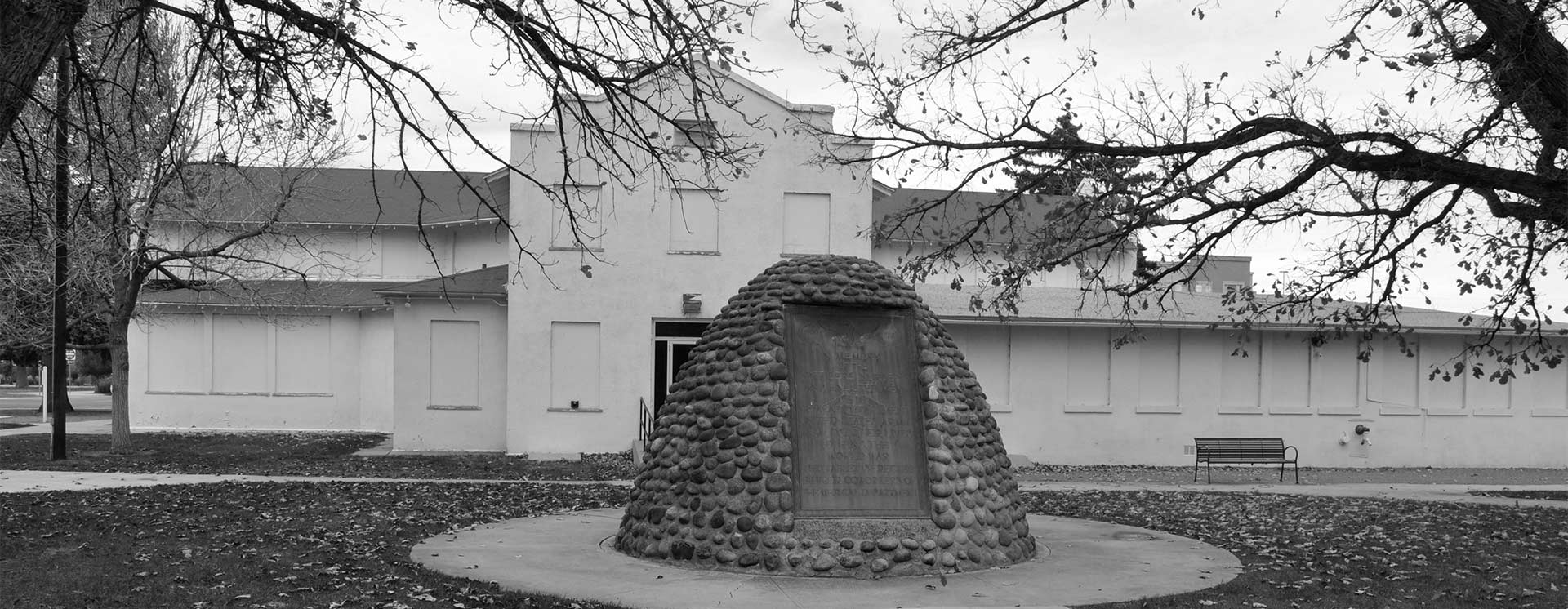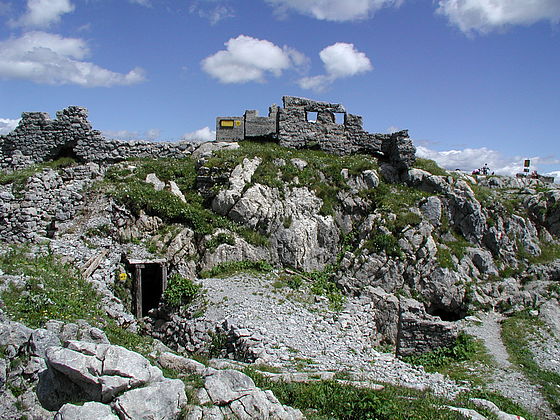
World War One Sites - The NETWORLD Database
Open-Air Museum of the Mountain War 1915–1917, Plöckenpass, Carinthia, Austria
The area of the “Open-Air Museum of the Mountain War 1915–1917 Plöckenpass” consists of the Hausalm, MG-Nase, Kleiner Pal and Cellonstollen sectors.
In the area of the Kleiner Pal sector more than 70 historic objects have again been made accessible.
Austria, Carinthia
Type of WWI-heritage
- Trench-system
- Military Infrastructure
Dimensions
The area of the “Open-Air Museum of the Mountain War 1915–1917 Plöckenpass” consists of the Hausalm, MG-Nase, Kleiner Pal and Cellonstollen sections.
State of repair/preservation
The constructional remains of the battles on the front during World War One in the area of Kleiner Pal are mostly still well-preserved.
Historical WWI Context
The Karnischer Kamm formed a section of the so-called Southwestern Front – the front situated between Austria-Hungary and Italy from May 1915 onwards. It stretched from the Swiss border to the Adriatic coast along a linear length of around 600 kilometres. Italian, Austro-Hungarian and German soldiers faced each other on this part of the front mainly between 1915 and 1918, primarily in high-Alpine terrain and usually at an altitude of 2,000 to 3,900 metres above sea level. In 1915, soldiers on both sides initially had to make the complete terrain suitable for military operations. Apart from a few mountains made accessible for tourists and trails used by the indigenous population in summer for cattle driving, hardly any well-developed paths or tracks existed between the Ortler (3,899 m) near to the Swiss border and the Julian Alps.
In the Plöcken region the Frischenkofel/Cellon (2,238 m) had major military importance for the Austro-Hungarian and Italian troops because of the Plöckenpass/Passo di Mt. Croce Carnico (1,357 m) and the Austro-Hungarian Plöcken blockade located there. In early summer of 1915 it was occupied alternately by the Italian and Austrian-Hungarian troops during the course of several operations. Italian troops then finally brought themselves into position. Austria-Hungarian troops on the other hand positioned themselves on the Cellon shoulder.
Kleiner Pal, initially occupied by Italian troops, should have been taken over in June 1915 by around 400 soldiers of the Austro-Hungarian army. However, military success for both sides was in the end moderate because the Italian and Austrian-Hungarian troops were separated from each other by just a few metres in the summit region of Kleiner Pal. As a consequence, both sides expanded their trenches on Kleiner Pal: they constructed caverns, galleries and tunnel systems in the summit area as well as cable systems and tracks across the front to ensure replenishments from the valley.
Recent Images






Historical Images
State of legal protection
The area is not under protection.
Owner
The area is in private hands.
Kind of cultural use of WWI
The “Open-Air Museum of the Mountain War 1915–1917” on the Plöckenpass can be visited for free. For special occasions, the Dolomitenfreunde association also offers organised walking tours in the open-air museum.
Further information:
www.dolomitenfreunde.at
The “Freilichtmuseum des Gebirgskrieges 1915–1917” is located on Karnischer Höhenweg (No. 403), that can be walked along between the Sillianer Hütte in East Tyrol and the Nassfeld in Carinthia. This hiking trail, also called the “Friedensweg / Via della Pace / Trail of Peace” was initiated by the Dolomitenfreunde association with the aim of making former World War I tracks across the front accessible again and conserving the heritage of the war in this region in the form of “trails of peace”.
Opening
“Museum 1915–18. Vom Ortler bis zur Adria " (From the Ortler to the Adriatic Coast), Kötschach-Mauthen
Season runs from 15 May – 15 October
Opening times during the season:
Monday to Friday 10am–1pm and 3pm–6pm
Saturday, Sunday and bank holidays 2pm–6pm
Visits by groups are also possible with appropriate pre-registration outside of opening times.
Further information:
www.dolomitenfreunde.at
Entrance Fee
The “Open-Air Museum of the Mountain War 1915–1917” consists of various parts that are located in close proximity. The sectors are not bordered or fenced off. Entry is free and is at the visitor's own risk.
Information regarding cities, villages, other touristic attractions (non-WWI) nearby
Further information:
Market town Kötschach-Mauthen: www.koemau.com
Region Karnische Alpen: www.karnische-alpen.com
Mountain climber villages: www.bergsteigerdoerfer.at
Karnischer Höhenweg: www.karnischer-hoehenweg.at
Lesachtal: www.lesachtal.com
Stadt Spittal am Millstättersee: www.millstaettersee.com/de/region-orte/spittal-drau/spittal-drau.html
Accomodation
Further information:
Market town Kötschach-Mauthen: www.koemau.com
Mountain climber villages: www.bergsteigerdoerfer.at
Region Karnische Alpen: www.karnische-alpen.com
Lesachtal: www.lesachtal.com/en
Public Transport
The region around Kötschach-Mauthen is well-connected to the public traffic network (buses).
Further information:
ÖBB: www.oebb.at
Further information sources
Publications:
Gabriele & Walther Schaumann, Unterwegs vom Pustertal zum Plöckenpass. Auf den Spuren der Karnischen Front 1915–1917, Klagenfurt (2003).
Gabriele & Walther Schaumann, Unterwegs vom Plöckenpass zum Kanaltal. Auf den Spuren der Karnischen Front 1915–1917, Klagenfurt (2004).
Gabriele & Walther Schaumann: Unterwegs zwischen Save und Soča. Auf den Spuren der Isonzofront 1915–1917, Klagenfurt (2005).
Julia Walleczek-Fritz & Peter Fritz, Ascend-Apprehend-Aspire. The First World War along Carnic Ridge between Sexten and Plöckenpass, Kartitsch/Sexten (2015).
Ludwig Wiedemayr, Weltkriegsschauplatz Osttirol. Die Gemeinden an der Karnischen Front im östlichen Pustertal, Lienz (2007).
Other heritage sites nearby
- Trail of Peace / Karnischer Höhenweg in the Carnic Alps, East Tyrol and Carinthia, Austria
- Austro-Hungarian Military cemetery Kreuztratte, Plöckenpass, Carinthia, Austria
- Chapel of Peace at Zollnersee, Carinthia, Austria
- Prinz-Heinrich Memorial chapel, East Tyrol, Austria
- Austro-Hungarian Military cemetery Hochgränten, East Tyrol, Austria
- Italian Charnel House Kobarid, Slovenia
- Russian chapel, Vršič, Slovenia
- Outdoor Museum Čelo, Bovec, Slovenia
- Outdoor Museum Kolovrat, Slovenia
- Outdoor Museum Ravelnik, Bovec, Slovenia
Museums Private Collections
“Museum 1915–18. Vom Ortler bis zur Adria” (From the Ortler to the Adriatic Coast), Kötschach-Mauthen (Carinthia)
“Open-Air Museum of the Mountain War 1915–1917”, Plöckenpass
The museum and open-air museum were established by the Austrian Dolomitenfreunde association and are still supervised by them.
Further information:
www.dolomitenfreunde.at
Open-Air Museum of the Mountain War 1915–1917, Plöckenpass, Carinthia, Austria
46.60333640060461 12.946917240753805 fileadmin/res/images/layout/standar-marker.pngLocation
